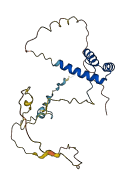| anterior/posterior pattern specification |
The regionalization process in which specific areas of cell differentiation are determined along the anterior-posterior axis. The anterior-posterior axis is defined by a line that runs from the head or mouth of an organism to the tail or opposite end of the organism. |
| cell differentiation |
The process in which relatively unspecialized cells, e.g. embryonic or regenerative cells, acquire specialized structural and/or functional features that characterize the cells, tissues, or organs of the mature organism or some other relatively stable phase of the organism's life history. Differentiation includes the processes involved in commitment of a cell to a specific fate and its subsequent development to the mature state. |
| determination of left/right symmetry |
The establishment of an organism's body plan or part of an organism with respect to the left and right halves. The pattern can either be symmetric, such that the halves are mirror images, or asymmetric where the pattern deviates from this symmetry. |
| digestive tract development |
The process whose specific outcome is the progression of the digestive tract over time, from its formation to the mature structure. The digestive tract is the anatomical structure through which food passes and is processed. |
| dorsal/ventral pattern formation |
The regionalization process in which the areas along the dorsal/ventral axis are established that will lead to differences in cell differentiation. The dorsal/ventral axis is defined by a line that runs orthogonal to both the anterior/posterior and left/right axes. The dorsal end is defined by the upper or back side of an organism. The ventral end is defined by the lower or front side of an organism. |
| embryonic hemopoiesis |
The stages of blood cell formation that take place within the embryo. |
| exocrine pancreas development |
The process whose specific outcome is the progression of the exocrine pancreas over time, from its formation to the mature structure. The exocrine pancreas produces and store zymogens of digestive enzymes, such as chymotrypsinogen and trypsinogen in the acinar cells. |
| heart development |
The process whose specific outcome is the progression of the heart over time, from its formation to the mature structure. The heart is a hollow, muscular organ, which, by contracting rhythmically, keeps up the circulation of the blood. |
| liver development |
The process whose specific outcome is the progression of the liver over time, from its formation to the mature structure. The liver is an exocrine gland which secretes bile and functions in metabolism of protein and carbohydrate and fat, synthesizes substances involved in the clotting of the blood, synthesizes vitamin A, detoxifies poisonous substances, stores glycogen, and breaks down worn-out erythrocytes. |
| lymphangiogenesis |
Lymph vessel formation when new vessels emerge from the proliferation of pre-existing vessels. |
| negative regulation of DNA-templated transcription |
Any process that stops, prevents, or reduces the frequency, rate or extent of cellular DNA-templated transcription. |
| negative regulation of transcription by RNA polymerase II |
Any process that stops, prevents, or reduces the frequency, rate or extent of transcription mediated by RNA polymerase II. |
| positive regulation of endothelial cell differentiation |
Any process that activates or increases the frequency, rate or extent of endothelial cell differentiation. |
| regulation of organ growth |
Any process that modulates the frequency, rate or extent of growth of an organ of an organism. |
| regulation of transcription by RNA polymerase II |
Any process that modulates the frequency, rate or extent of transcription mediated by RNA polymerase II. |
| sprouting angiogenesis |
The extension of new blood vessels from existing vessels into avascular tissues, this process includes the specialization of endothelial cells into leading tip and stalk cells, proliferation and migration of the endothelial cells and cell adhesion resulting in angiogenic sprout fusion or lumen formation. |
| thyroid gland development |
The process whose specific outcome is the progression of the thyroid gland over time, from its formation to the mature structure. The thyroid gland is an endoderm-derived gland that produces thyroid hormone. |


